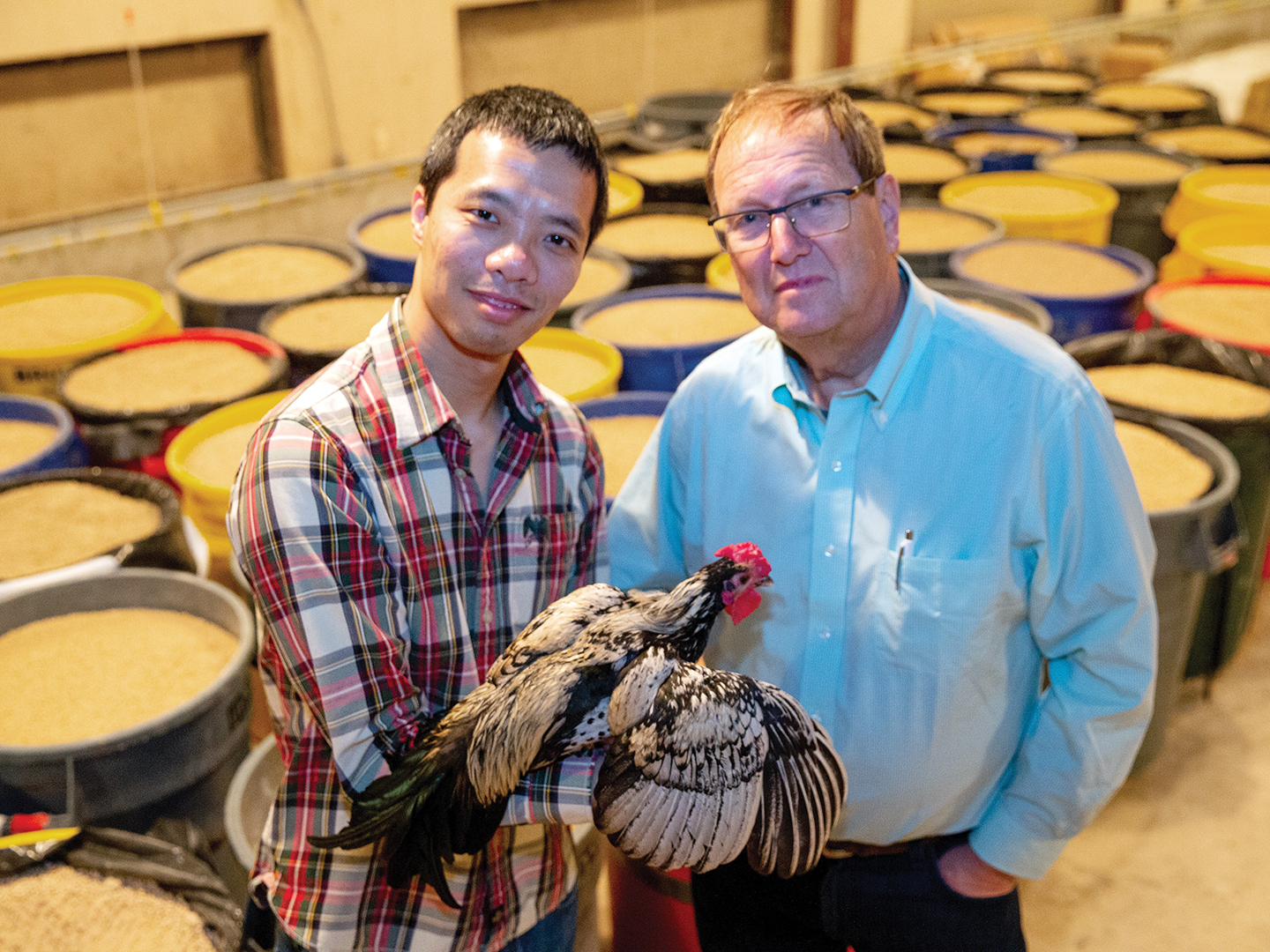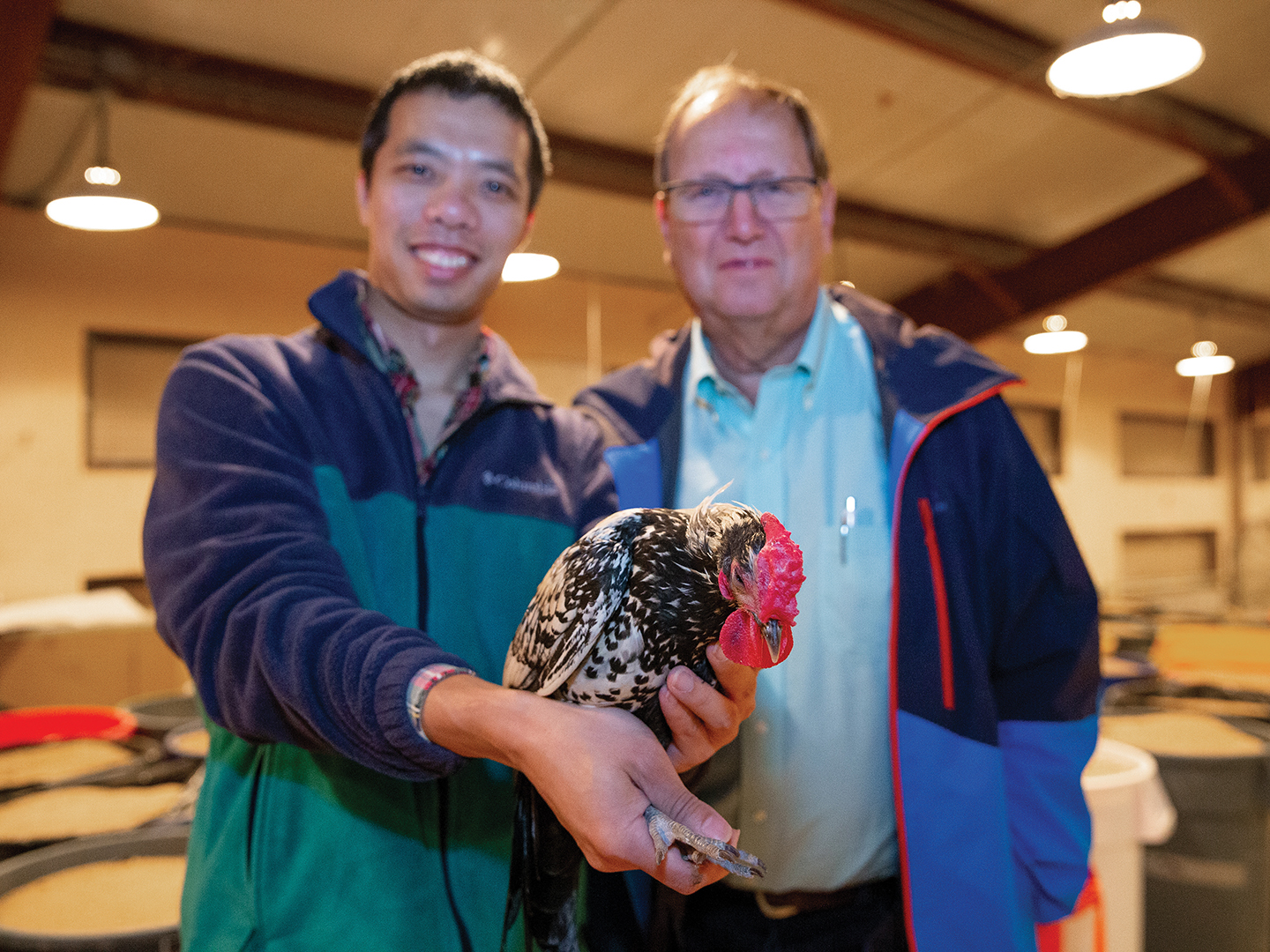A Wonder-Full Life: Dr. Leif Andersson
Story by Margaret Preigh, CVMBS Communications
As a pioneer of domestic animal genetics, Dr. Leif Andersson is driven by a fascination in the things he can’t explain.

The world of genetics might at first seem to be far removed from our daily lives, conjuring images of glass test tubes and sterile gloves contained within a laboratory. However, Dr. Leif Andersson, a professor at the Texas A&M College of Veterinary Medicine & Biomedical Sciences (CVMBS), brings this world to a more domestic sphere.
Andersson is among the first to have applied molecular genetic techniques to domestic animals. He has worked with pigs, chickens, horses, finches, dogs, herring, cattle, and more. Though Andersson’s scope of research may seem wide, he remains fascinated with the same question throughout multiple model organisms.
“My general passion in science is to understand the relationship between genetic variation and the phenotypic variation that we can observe,” Andersson said, referring to the relationship between what the genes of an organism encode vs. that individual’s physical appearance.
“The human, horse, chicken, and fish genomes have on the order of 20,000 genes,” Andersson said. “We know quite well what some of these genes do, but a lot of them we have a very limited understanding of.”
Indeed, just because we have great familiarity with an animal doesn’t mean that we entirely understand what is going on at a molecular level. Great mysteries remain in the genetic networks that sculpt everything from grasses to humans. Even though scientists have successfully sequenced the human genome, we still don’t know the functions of many of those 20,000 genes. Andersson hopes his research is a step toward unraveling the mysteries of our DNA.
Farmyard Genetics
Andersson’s career began in his home country of Sweden, where he holds a dual professorship at Uppsala University. He earned his undergraduate degrees in Chemistry and Biology at the University of Stockholm before pursuing a Ph.D. in Animal Breeding and Genetics at Uppsala University.
“I took biology as my undergraduate, but then almost by accident I ended up in the agricultural university and I started work with domestic animals,” Andersson said. After graduating from his undergraduate institution, Andersson sought out work as a biologist, hoping to become involved with ecological protection.
Andersson instead found a position at the Swedish University of Agricultural Sciences working on a project that analyzed genetic data from horses to establish pedigrees for breeding purposes. Using this data set, Andersson was able to map two genes that determined a horse’s coat color.
This research culminated in Andersson’s Ph.D. and kick-started his career as a pioneer of domestic animal genetics. He said that human meddling with the breeding of domestic animals makes them fascinating subjects in comparison to more traditional model organisms.
“The strength for these domestic animals is that they have gone through such a rapid evolution. Their domestication started 10,000 years ago,” he said. “Since then, we have transformed horses, cattle, pigs, and chicken into the variety of forms that suit human needs.”
Andersson said his research is fueled primarily by curiosity. Often, finding the next trait he will study is as simple as noticing some trait in the wild, then searching for the mechanism behind that trait. Anderson said, “Everything I can’t explain is of interest.”
Swine And Dine
Genetic research often functions at the level of gaining basic knowledge about a specific pathway, which may seem divorced from reality to the untrained observer. However, Andersson’s research has demonstrated how insights into gene function can lead to sizable cultural and economic payoffs.
One example of this is Andersson’s research into an IGF2 mutation in pigs. When observing muscle mass, fat deposition, and heart size in different types of wild and domestic pigs, Andersson noted that alleles from domestic breeds increased muscle mass and decreased back-fat thickness. In genetics, an allele is a version of a gene, like different flavors of the same food.
Using genetic analysis, Andersson’s team determined a selection of genes that were likely to contribute to this physiological change. From their pool of candidate genes, Andersson and his team used selective breeding, genetic sequencing, and other genetic tests to determine that a mutation in the gene IGF2 created an allele that was likely responsible for the observed trait.
IGF2, also known as Insulin Growth Factor 2, can be mutated in a certain place where protein interactions will encourage expression of this gene at three times its normal level. This translates to a 10-20 percent variation in back-fat thickness and 15-30 percent variation in muscle mass. This change can provide a boost in food production efficiency.
“This mutation means that, for each pig, food producers get about 4 kg more meat. It shunts the pig’s energy towards meat muscle production rather than fat,” Andersson said. “You get a leaner pig that produces protein basically, and that is exactly what the consumer pays for.”

Virus Fighter
From this same IGF2 research, Andersson also identified a factor called ZBED6. When IGF2 is mutated to the form that increases muscle production, ZBED6 is no longer able to interact with IGF2. This disruption accounts for increased production of the mutated IGF2 gene and a corresponding increase in muscle mass, as ZBED6 discourages IGF2 expression in the unmutated form.
As Andersson investigated the function of ZBED6, he identified it as a transposon, or a “jumping gene.” These genes encode an enzyme that allows them to cut themselves out of a certain spot and “jump” into the organism’s DNA at another location. As expected, these sequences can be highly mobile, though most of them stopped their jumping a long time ago in the mammalian genome. These jumping genes usually settle down inside of another gene, so they can freeload off of the permanent gene’s on/off switch, and other regulatory hardware required for expression.
When ZBED6 decided to settle down in its current location, it teamed up with another gene that is very important in helping the cell transport genetic material in and out of its control center, or nucleus. Unfortunately, some harmful viruses, like HIV and influenza, have caught onto this role and hitchhike on this transport protein to the cytoplasm where virus proteins are made.
Andersson hopes that he and his team can use the knowledge they gained from understanding this pathway to develop a medicine that blocks protein interactions with viruses, and as such hinders the virus’s ability to spread within the body.
“With influenza we have the flu shot, but the fear is that a new version of influenza that we don’t have a vaccine for will come up, and then you need something else that could block this virus,” Andersson said. Blocking the ZBED6 pathway would allow the same drug to block many different strains of the flu. A drug like the one he is working to develop would also be able to fight the active infection, unlike a vaccine which must be given to an uninfected individual.
Andersson’s path from discovering how to increase meat production to how to fight viral infections demonstrates the unexpected discoveries one can find from studying how genes work, and just how useful these discoveries can prove to be.
A Look At Feathers
At the CVMBS, Andersson is currently working on research concerned with explaining the variation of feather color in chickens. By breeding chickens with different traits together and observing the traits of their offspring, Andersson hopes to gain insight into how different patterns are created.
Who we are is largely determined by our genes and our environment, which means that a large portion of what we will look like is predetermined at a very early stage of development. For example, some cells are destined to become heart tissue, while others are instructed to become feathers. Breaking cell fate down further, some feathers might become short and white, while others will be directed to be long and spotted.
Andersson’s research works to decipher the genes behind variations in feather color within a single chicken. Though understanding why different sets of feathers in the same chickens look the way they do might at first seem to be a frivolous endeavor, Andersson asserts that understanding the genetic basis of a trait might lead to future discoveries, as has occurred in his previous research.
“I think today there’s a tendency to go towards applied research, that it should have an immediate impact,” he said. “I think it’s also really important to maintain these supportive fields of basic knowledge because it’s always difficult to know where solutions to important problems are coming from.”
Global Solutions
The broad scope and open mind Andersson maintains in his research efforts have paid off, resulting in a diverse array of findings and prestigious recognitions such as membership in the US National Academy of Sciences and the 2014 Wolf Prize in Agriculture, among others. In total, Andersson has authored more than 400 scientific papers and is widely considered a pioneer in the field of functional genomics for his work with domestic animals.
At the root of Andersson’s success is not only a brilliant mind, but also curiosity and the trust that his research, no matter how abstracted it may seem at times, brings important contributions and applications to the real world.
“I have this keen interest to understand how things function,” Andersson said. “Research is trying to understand the world, I would say. When you get insight, new knowledge that no one has had before, that is really rewarding.”
Andersson’s efforts operate at a global level: he holds dual professorships at the CVMBS and Uppsala University in Sweden, and splits his time between the two countries. Andersson emphasizes the importance of exchanging ideas between scientific communities. He asserts that science is an international endeavor used to solve international problems. The issues he works to tackle, including disease and food insecurity, are of universal concern.
“These new genomic tools that we have give us basic new knowledge about biology,” he said. “That improved basic knowledge can open up the possibilities for practical applications, so you can breed healthier animals, you can also maintain biodiversity in natural populations.”
Andersson advises that we must be mindful of how we apply genetic modification in our future, but that if done correctly, it can be a tool in making our future a bright one.
###
Note: This story originally appeared in the Spring 2020 edition of CVM Today.
For more information about the Texas A&M College of Veterinary Medicine & Biomedical Sciences, please visit our website at vetmed.tamu.edu or join us on Facebook, Instagram, and Twitter.
Contact Information: Jennifer Gauntt, Director of Communications, Texas A&M College of Veterinary Medicine & Biomedical Sciences; jgauntt@cvm.tamu.edu; 979-862-4216


